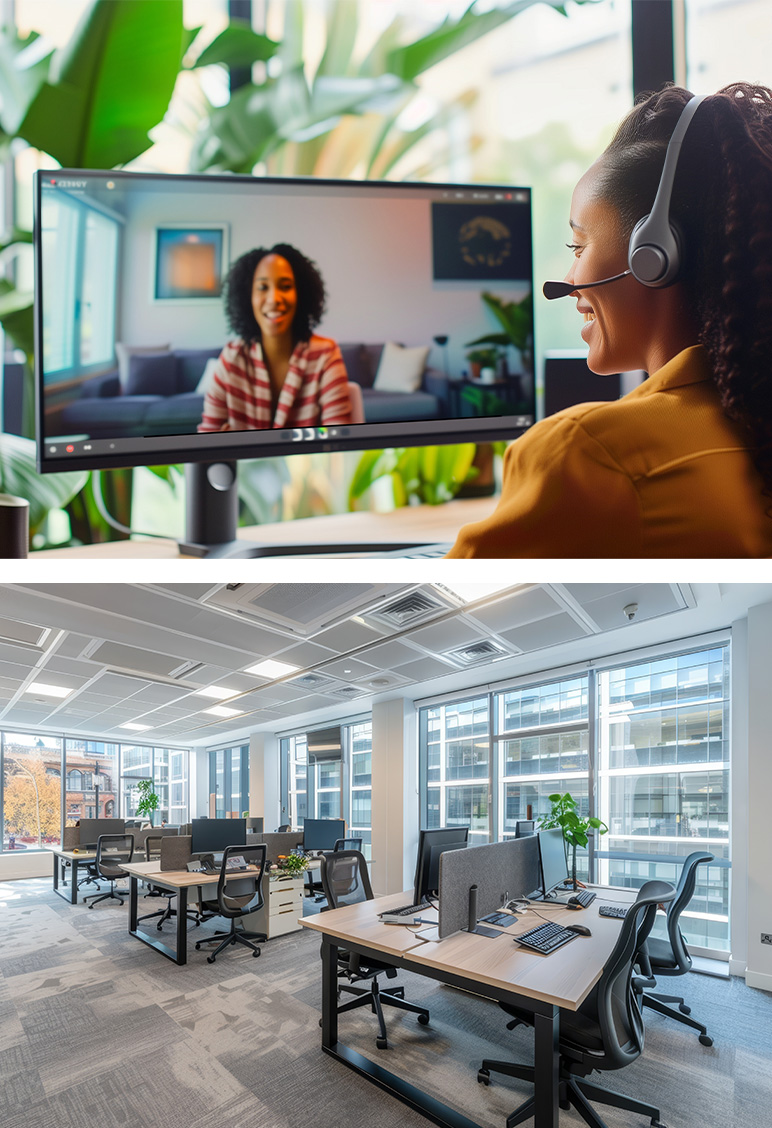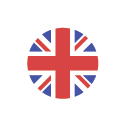A Look into Flexible Workspaces
In the evolving landscape of the modern workplace, organisations are continually redefining the traditional office environment to cater to the needs of a hybrid workforce. A significant aspect of this transformation is reimagining conventional meeting rooms into multipurpose spaces. This shift supports a more dynamic and collaborative work culture and leverages flexible technology to create a seamless and efficient work experience. In this blog article, we will explore how organisations transform traditional meeting rooms and how flexible technology is integral to this change.
As organisations embrace the hybrid work model, the need for versatile and adaptable meeting spaces has never been greater.
The Shift to Multipurpose Spaces
From Static to Dynamic
Static layouts have long characterised traditional meeting rooms. Pre-pandemic, they had a large conference table, chairs, and perhaps a projector, whiteboard or passive display. These rooms were designed for one primary function: formal meetings. However, the rise of the hybrid workforce, which blends remote and in-office employees, demands a more versatile approach. Organisations are now turning these static spaces into dynamic multipurpose environments. These redesigned spaces can adapt to various activities such as team collaboration, brainstorming sessions, virtual meetings, workshops, and casual gatherings. The flexibility to reconfigure the room layout quickly and easily is critical to meeting the diverse needs of today’s workforce.Embracing a Hybrid Culture
The hybrid work model combines the benefits of remote work and in-office presence, allowing employees to choose the work environment that best suits their tasks and personal preferences. To support this model, meeting rooms must be equipped to handle both in-person and virtual interactions seamlessly. Multipurpose spaces address this need by incorporating technology that enables smooth communication and collaboration regardless of the participants' physical locations. This integration ensures remote team members feel equally included and engaged in discussions, fostering a more cohesive and productive team dynamic.
Flexible Technology: The Backbone of Modern Workspaces
Advanced Collaboration Tools
The deployment of advanced collaboration tools is the cornerstone of transforming traditional meeting rooms into multipurpose spaces. Interactive displays, for instance, have revolutionised how teams collaborate, brainstorm, and share ideas. Collaboration is further enhanced by enabling users to write, draw, and annotate in real-time, instantly saving and sharing the content with anyone, anywhere in the world. Moreover, video collaboration platforms have become more sophisticated, offering features such as high-definition video, noise-cancellation microphones, and intelligent speaker tracking. These systems ensure that all participants can see, hear, and be heard clearly, whether in the room or joining meetings remotely.Integrated Room Booking Systems
Flexibility also extends to how these spaces are managed. Integrated room booking systems simplify reserving a meeting room and ensure the space is used efficiently. These systems can show real-time availability, provide usage analytics, and suggest alternative times if the desired slot is booked. Incorporating these systems with an organisation's calendar platform helps avoid scheduling conflicts and maximises the utilisation of meeting rooms. This seamless integration is crucial for a hybrid workforce where coordination between remote and in-office employees is essential.Smart Furniture and Modular Design
The physical environment must be adaptable to truly create multipurpose spaces. Smart furniture and modular design concepts play a pivotal role in this transformation. For example, tables and chairs on casters can be easily rearranged to suit different meeting formats, from formal presentations to casual group discussions. Modular walls and partitions also allow rooms to be resized as needed, creating larger spaces for workshops or smaller areas for focused work. The ability to customise the physical layout of a meeting room on the fly enhances its functionality and supports a variety of work styles and activities.IoT and Environmental Controls
The Internet of Things (IoT) brings flexibility and convenience to modern meeting rooms. IoT-enabled devices can control lighting, temperature, and air quality, creating a comfortable and conducive environment for any meeting. For example, sensors can adjust lighting based on the time of day or the number of people in the room. Similarly, smart thermostats can maintain optimal temperatures, ensuring everyone remains comfortable throughout the meeting. These environmental controls contribute to a more pleasant and productive workspace.Conclusion
As organisations embrace the hybrid work model, the need for versatile and adaptable meeting spaces has never been greater. By transforming traditional meeting rooms into multipurpose environments, companies can better support their diverse workforce and foster a culture of collaboration and innovation. Flexible technology is at the heart of this transformation, providing the tools and capabilities needed to create seamless and efficient work experiences. The possibilities for creating dynamic and adaptable workspaces are endless, from advanced collaboration tools and integrated booking systems to smart furniture and IoT controls. As we move forward, the continued evolution of these spaces will undoubtedly play a crucial role in the success of hybrid work strategies, enabling organisations to thrive in the ever-changing world of work.

A Look into Flexible Workspaces
In the evolving landscape of the modern workplace, organisations are continually redefining the traditional office environment to cater to the needs of a hybrid workforce. A significant aspect of this transformation is reimagining conventional meeting rooms into multipurpose spaces. This shift supports a more dynamic and collaborative work culture and leverages flexible technology to create a seamless and efficient work experience. In this blog article, we will explore how organisations transform traditional meeting rooms and how flexible technology is integral to this change.
As organisations embrace the hybrid work model, the need for versatile and adaptable meeting spaces has never been greater.
The Shift to Multipurpose Spaces
From Static to Dynamic
Static layouts have long characterised traditional meeting rooms. Pre-pandemic, they had a large conference table, chairs, and perhaps a projector, whiteboard or passive display. These rooms were designed for one primary function: formal meetings. However, the rise of the hybrid workforce, which blends remote and in-office employees, demands a more versatile approach. Organisations are now turning these static spaces into dynamic multipurpose environments. These redesigned spaces can adapt to various activities such as team collaboration, brainstorming sessions, virtual meetings, workshops, and casual gatherings. The flexibility to reconfigure the room layout quickly and easily is critical to meeting the diverse needs of today’s workforce.Embracing a Hybrid Culture
The hybrid work model combines the benefits of remote work and in-office presence, allowing employees to choose the work environment that best suits their tasks and personal preferences. To support this model, meeting rooms must be equipped to handle both in-person and virtual interactions seamlessly. Multipurpose spaces address this need by incorporating technology that enables smooth communication and collaboration regardless of the participants' physical locations. This integration ensures remote team members feel equally included and engaged in discussions, fostering a more cohesive and productive team dynamic.Flexible Technology: The Backbone of Modern Workspaces
Advanced Collaboration Tools
The deployment of advanced collaboration tools is the cornerstone of transforming traditional meeting rooms into multipurpose spaces. Interactive displays, for instance, have revolutionised how teams collaborate, brainstorm, and share ideas. Collaboration is further enhanced by enabling users to write, draw, and annotate in real-time, instantly saving and sharing the content with anyone, anywhere in the world. Moreover, video collaboration platforms have become more sophisticated, offering features such as high-definition video, noise-cancellation microphones, and intelligent speaker tracking. These systems ensure that all participants can see, hear, and be heard clearly, whether in the room or joining meetings remotely.Integrated Room Booking Systems
Flexibility also extends to how these spaces are managed. Integrated room booking systems simplify reserving a meeting room and ensure the space is used efficiently. These systems can show real-time availability, provide usage analytics, and suggest alternative times if the desired slot is booked. Incorporating these systems with an organisation's calendar platform helps avoid scheduling conflicts and maximises the utilisation of meeting rooms. This seamless integration is crucial for a hybrid workforce where coordination between remote and in-office employees is essential.Smart Furniture and Modular Design
The physical environment must be adaptable to truly create multipurpose spaces. Smart furniture and modular design concepts play a pivotal role in this transformation. For example, tables and chairs on casters can be easily rearranged to suit different meeting formats, from formal presentations to casual group discussions. Modular walls and partitions also allow rooms to be resized as needed, creating larger spaces for workshops or smaller areas for focused work. The ability to customise the physical layout of a meeting room on the fly enhances its functionality and supports a variety of work styles and activities.IoT and Environmental Controls
The Internet of Things (IoT) brings flexibility and convenience to modern meeting rooms. IoT-enabled devices can control lighting, temperature, and air quality, creating a comfortable and conducive environment for any meeting. For example, sensors can adjust lighting based on the time of day or the number of people in the room. Similarly, smart thermostats can maintain optimal temperatures, ensuring everyone remains comfortable throughout the meeting. These environmental controls contribute to a more pleasant and productive workspace.Conclusion
As organisations embrace the hybrid work model, the need for versatile and adaptable meeting spaces has never been greater. By transforming traditional meeting rooms into multipurpose environments, companies can better support their diverse workforce and foster a culture of collaboration and innovation. Flexible technology is at the heart of this transformation, providing the tools and capabilities needed to create seamless and efficient work experiences. The possibilities for creating dynamic and adaptable workspaces are endless, from advanced collaboration tools and integrated booking systems to smart furniture and IoT controls. As we move forward, the continued evolution of these spaces will undoubtedly play a crucial role in the success of hybrid work strategies, enabling organisations to thrive in the ever-changing world of work.

